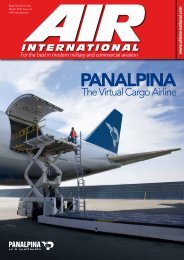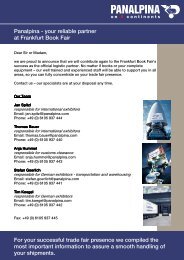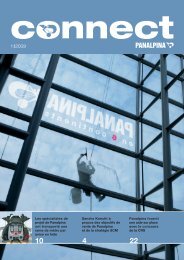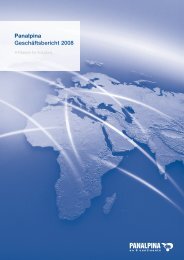Panalpina Annual Report 2006
Panalpina Annual Report 2006
Panalpina Annual Report 2006
Create successful ePaper yourself
Turn your PDF publications into a flip-book with our unique Google optimized e-Paper software.
Consolidated and <strong>Annual</strong> Financial Statements <strong>2006</strong><br />
86 <strong>Panalpina</strong> <strong>Annual</strong> <strong>Report</strong> <strong>2006</strong><br />
Financial risk factors<br />
Currency risk<br />
The Group operates internationally and is exposed to foreign exchange risk arising from various currency exposures,<br />
primarily in regard to the USD. Foreign exchange risk arises from future commercial transactions, recognized assets and<br />
liabilities as well as net investments in foreign operations.<br />
To manage foreign exchange risks arising from future commercial transactions or recognized assets and liabilities,<br />
entities in the Group use forward contracts, transacted generally with Group Treasury. Foreign exchange risk arises when<br />
future commercial transactions or recognized assets and liabilities are denominated in a currency that is not the Group<br />
entity’s measurement currency. Group Treasury is responsible for managing the net position using external derivatives<br />
contracts.<br />
Interest rate risk<br />
The absence of significant interest bearing liabilities in general and their short-term nature limit exposure to interest rate risk.<br />
The Group has a clear funding policy that forbids affiliates from borrowing in foreign currency and has a clear preference<br />
for intra-group financing. Affiliates are also required to repatriate their excess cash. Liquidity is mainly managed at corporate<br />
level by using money market products. Derivative instruments are used to manage duration of financial instruments in a<br />
prudent way.<br />
Credit risk<br />
Credit risk stems from a counterparty’s failure to meet its obligation. The Group is exposed to credit risk on financial<br />
instruments mainly with its liquid assets, derivatives assets and trade receivables. Credit risk is managed in accordance with<br />
clear and established guidelines.<br />
Liquid assets are invested with highly rated borrowers and there is no exposure of credit risk.<br />
Trade receivables are strictly monitored and clear guidelines are established in order to set credit limits, approval procedures,<br />
and procedures to monitor overdue items. Concentration of credit risk in trade receivables is immaterial.<br />
Settlement risk<br />
This risk is managed by monitoring counterparty activity, settlement limits and by fixing clear limits.<br />
Liquidity risk<br />
The Group holds highly liquid securities. Liquid assets and marketable securities usually have a short-term horizon in order<br />
to match any funding needs.<br />
Insurance risk<br />
The Group has established a captive reinsurance company, Mondi Reinsurance Ltd., Hamilton, Bermuda, that insures<br />
a dedicated risk portion of its errors and omissions, transport-operator and commercial general liability programs. The<br />
exposure of its captive reinsurance company is limited by a third-party insurer that covers losses exceeding an amount<br />
of CHF 1 million on a single case basis and a total aggregate limit of CHF 9 million annually, for claims exceeding<br />
CHF 50,000 per incident. In a consolidated view, the Group, through its captive reinsurance company, bears the risks<br />
insured with its captive reinsurance company up to the limit as if such risks were not insured at all. Furthermore, as third<br />
party coverage is subject to a considerable deductible and a total aggregated limit per year, the Group, in effect, bears the<br />
risk of damages, losses and claims that are above such aggregated limits as well.<br />
The Group has supplemented its insurance program with a claims management and a claims handling system that ensure<br />
transparency of the Group’s risk profile and the proper handling of any claim.<br />
Accounting for derivative financial instruments and hedging activities<br />
Derivative financial instruments are used to hedge foreign currency and interest rate risk. All derivatives are initially<br />
recognized at fair value on the date a derivative contract is entered into and are subsequently remeasured at fair value. The<br />
method of recognizing the resulting gain or loss depends on whether the derivative qualifies as a hedging instrument, and if<br />
so, the nature of the item being hedged.<br />
To qualify for hedge accounting, the hedging relationship must meet several strict conditions regarding documentation,<br />
probability of occurrence, hedge effectiveness and reliability of measurement. If these conditions are not met, then the<br />
financial instrument does not qualify for hedge accounting. In this case, the hedging instrument and the hedged item<br />
are valued independently of one another. The derivative hedging instrument is reported at fair value with the changes in fair<br />
value included in income (expenses).<br />
For qualifying fair value hedges, the derivative financial instruments are carried at fair value and gains or losses are<br />
recognized in profit or loss. Additionally, the fair value gain or loss on the hedged item attributable to the hedged risk is<br />
recognized in profit or loss.



![Eigenes Luftfrachtnetzwerk [pdf | 244 KB] - Panalpina](https://img.yumpu.com/23347328/1/184x260/eigenes-luftfrachtnetzwerk-pdf-244-kb-panalpina.jpg?quality=85)
![Übersicht Panalpina [pdf | 240 KB]](https://img.yumpu.com/22547731/1/184x260/ubersicht-panalpina-pdf-240-kb.jpg?quality=85)

![Seefracht [pdf | 181 KB] - Panalpina](https://img.yumpu.com/22234724/1/184x260/seefracht-pdf-181-kb-panalpina.jpg?quality=85)
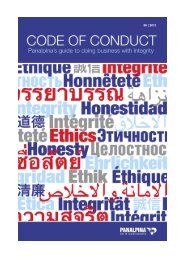
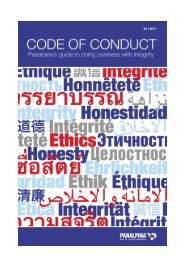

![Annual Report 2012 [pdf | 1 MB] - Panalpina](https://img.yumpu.com/15342099/1/184x260/annual-report-2012-pdf-1-mb-panalpina.jpg?quality=85)

